When the experts talk about emergency preparedness, most frequently they focus on short-term solutions: water storage, food, generators etc. But the homeowners who include emergency preparedness in their home designs can better weather the extended emergency beyond a few days without electricity.
Probably the easiest time to incorporate emergency preparedness features is when building a new home. Adding to or upgrading customary systems in a home for availability during extended periods of time without electricity is easier and more seamless than retrofitting once the home is completed.
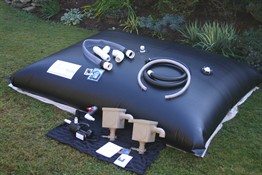 Water Storage Options— Designing in an extra cistern may make sense for homes built in areas where drought or water contamination from frequent flooding may be an issue. Another great option is the Original Rainwater Pillow®, which an oversized polyurethane bladder that can be stowed in underutilized areas such as beneath porches, decks or in crawlspaces. The Original Rainwater Pillow can be set up to capture rainwater from the roofs of neighboring structures, ground based sources or filled in advance of an emergency from a well or other water source. The captured water is pre-filtered before being stored in the pillow. Once stored in the pillow, a secondary filtration system would be required to treat the water to meet EPA drinking water standards. The water can be accessed by either a manual or electric pump.
Water Storage Options— Designing in an extra cistern may make sense for homes built in areas where drought or water contamination from frequent flooding may be an issue. Another great option is the Original Rainwater Pillow®, which an oversized polyurethane bladder that can be stowed in underutilized areas such as beneath porches, decks or in crawlspaces. The Original Rainwater Pillow can be set up to capture rainwater from the roofs of neighboring structures, ground based sources or filled in advance of an emergency from a well or other water source. The captured water is pre-filtered before being stored in the pillow. Once stored in the pillow, a secondary filtration system would be required to treat the water to meet EPA drinking water standards. The water can be accessed by either a manual or electric pump.
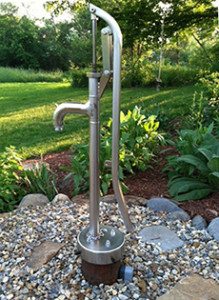 Water Access Options—If your home is serviced by a private well, a hand water pump like the ones manufactured by Bison Pumps can provide water and also serve to free up a backup generator electrical circuit for other appliances. Bison Pumps are made of high-grade stainless steel with brass fittings and are designed to work alongside existing submersible well pumps. The pump also provides a better seal on the well head to protect against well contamination from flooding. While there is a hook for hanging a bucket on the spout, Bison Pumps are also equipped with a threaded spout to accommodate a common garden hose. Connect the hose to any exterior water faucet and pump to energize interior water systems so that toilets can be flushed, showers and sink faucets can flow. (For potable water, filtration and boiling are recommended.)
Water Access Options—If your home is serviced by a private well, a hand water pump like the ones manufactured by Bison Pumps can provide water and also serve to free up a backup generator electrical circuit for other appliances. Bison Pumps are made of high-grade stainless steel with brass fittings and are designed to work alongside existing submersible well pumps. The pump also provides a better seal on the well head to protect against well contamination from flooding. While there is a hook for hanging a bucket on the spout, Bison Pumps are also equipped with a threaded spout to accommodate a common garden hose. Connect the hose to any exterior water faucet and pump to energize interior water systems so that toilets can be flushed, showers and sink faucets can flow. (For potable water, filtration and boiling are recommended.)
 Refrigeration Options—Anyone with a remote camp is familiar with propane refrigerators. For emergency preparedness, a propane refrigerator set up in an adjacent garage or basement area can keep food fresh during an extended period without electricity. These units can be found with refrigerator alone, freezer or combination. There are several manufacturers who offer these propane-powered options, including EZ-Freeze, Crystal Cold and Blizzard. Check with local dealers to see which might be the best option.
Refrigeration Options—Anyone with a remote camp is familiar with propane refrigerators. For emergency preparedness, a propane refrigerator set up in an adjacent garage or basement area can keep food fresh during an extended period without electricity. These units can be found with refrigerator alone, freezer or combination. There are several manufacturers who offer these propane-powered options, including EZ-Freeze, Crystal Cold and Blizzard. Check with local dealers to see which might be the best option.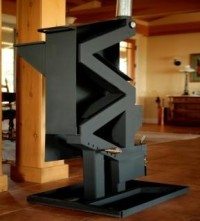
Heat options— While a fireplace can provide some comfort, one of the best emergency heat options is a wood stove. Some manual pellet stoves can operate without electricity, including an interesting option made by Wiseway. Its design uses a gravity fed hopper with no auger or electric fan. The most interesting feature is that it is a semiportable unit, that could be utilized on an emergency basis, then stored when not in use. At $2000 or less, it’s an interesting option for homes that experience frequent, prolonged electrical interruptions.
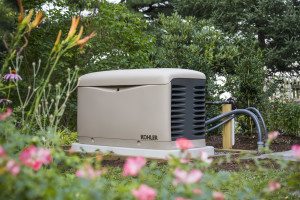 Electricity Options—Many rural homes are already set up with a portable gasoline powered generator. One easy upgrade when building a new home is to include a Generac-style inverter tied into essential electrical circuits in the home: lighting, furnace, refrigerator, septic pump and/or water well pump. This provides an added safety feature to avoid electrical surges when the power returns, since it is on a separate master circuit that is switched prior to starting the generator. Other rural property homeowners are opting for propane powered on-demand generators like those made by Kohler. These generators are becoming more popular, and as a result, service and maintenance are easily accessible.
Electricity Options—Many rural homes are already set up with a portable gasoline powered generator. One easy upgrade when building a new home is to include a Generac-style inverter tied into essential electrical circuits in the home: lighting, furnace, refrigerator, septic pump and/or water well pump. This provides an added safety feature to avoid electrical surges when the power returns, since it is on a separate master circuit that is switched prior to starting the generator. Other rural property homeowners are opting for propane powered on-demand generators like those made by Kohler. These generators are becoming more popular, and as a result, service and maintenance are easily accessible.
Carbon Monoxide & Smoke Sensors — Along with emergency heat sources, homes are more vulnerable to carbon 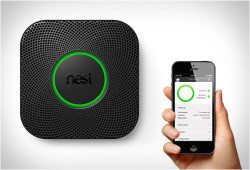 monoxide and home fires, especially with options that are not in regular use. Nest has developed a terrific combination smoke and CO2 detector, called Nest Protect. It is available in battery or hardwired versions, and overcomes many of the annoying features of other detection, including regular testing, chirping low batteries, and inability to remotely turn it off if all it’s detecting is burnt toast. Its active status is readily viewable and a smartphone app will deactivate a false alarm quickly.
monoxide and home fires, especially with options that are not in regular use. Nest has developed a terrific combination smoke and CO2 detector, called Nest Protect. It is available in battery or hardwired versions, and overcomes many of the annoying features of other detection, including regular testing, chirping low batteries, and inability to remotely turn it off if all it’s detecting is burnt toast. Its active status is readily viewable and a smartphone app will deactivate a false alarm quickly.
Communication Options — Even though it sounds a bit “old school,” rural homeowners should consider including a single hardwired telephone, that is connected directly to the phone system, without being plugged into an electrical outlet. In an emergency, cell towers can  be either overwhelmed or put out of service, while telephone lines rarely go out of service completely. A hard-wired phone line will enable family members to communicate and to reach ambulance or fire emergency responders services.
be either overwhelmed or put out of service, while telephone lines rarely go out of service completely. A hard-wired phone line will enable family members to communicate and to reach ambulance or fire emergency responders services.
Remember, the local and state emergency preparedness generally focuses on a few days, but families, especially in rural areas at the outer edges of services may need to be more resourceful and plan for longer emergency conditions.
